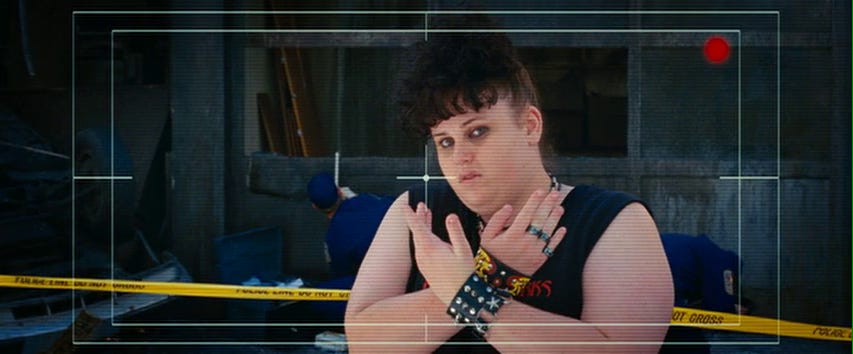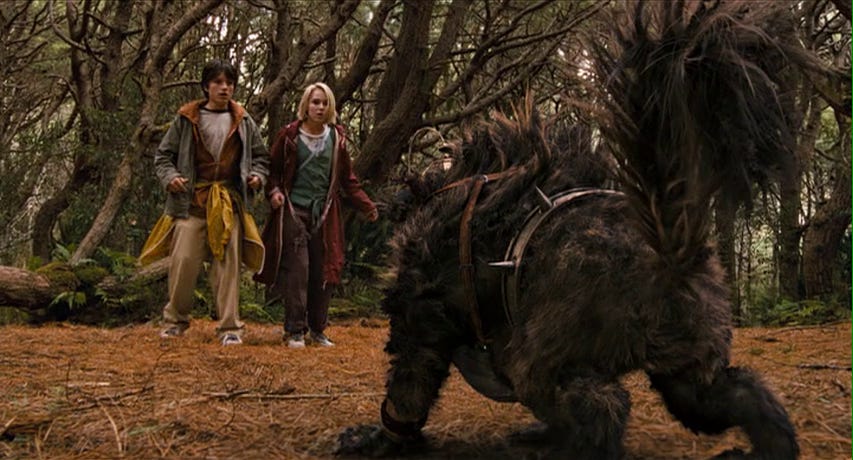Last week in this very newsletter I made the assertion that there is something dignified in assessing something from the past and confirming that we got it right the first time. I stand by that assertion. I sat through Norbit to save humanity from experiencing a two hour bad time because they thought it might be secretly good. We thought it sucked then and I can confirm that it sucks now. What might be implied by that assertion though is that finding something that has been mis-assessed by the past does not offer any such reward. This is not true. While it’s edifying to dig in dirt assumed to be barren and confirm there’s nothing there; on the other hand it is a true joy to take a shovel to a plot of land that has been written off and discover that there’s gold. Folks, Ghost Rider is that gold.
Ghost Rider is the story of Johnny Blaze (Nicolas Cage), a stunt motorcycle driver who gets the opportunity to sell his soul to Mephistopheles (Peter Fonda) to save his father from the cancer ravaging his body. Unfortunately Johnny’s dad immediately dies in a motorcycle crash causing Johnny to feel cheated by Mephistopheles, who tells him that he’ll collect on his debt later in Johnny’s life. Years afterwards Johnny is one of the greatest stunt drivers around, attracting stadium sized crowds who come to see him perform ever-more dangerous stunts which he always miraculously survives. As this great success he reconnects with his teenage sweetheart Roxanne (Eva Mendes) with whom he sees the possibility of settling down and living a normal life, but unfortunately this is when Mephistopheles decides to cash in his contract. He gives Johnny demonic powers, turning him into a flaming skeleton with a supernatural motorcycle in the presence of evil so that he can hunt down his wayward son Blackheart (Wes Bentley) who is intent on raising a demonic army to claim Mephistopheles’s demonic sovereignty. Johnny — after some mentoring by a mysterious stranger working in a cemetery (Sam Elliott) — goes after the rogue demons and brings order to the world.

When people talk about film and what makes it compelling or not, they often default to a standard set of attributes: characters, story, visual composition, dialogue, quality of performance, things like that. There is an attribute I find is under-discussed, which is that of spectacle. Spectacle is the swell of joy one feels when seeing Fred & Ginger dance. It is the feeling of awe upon beholding the dinosaurs in Jurassic Park (1993). It is the thrill of wild west shootouts from Stagecoach (1939) to True Grit (2010). I would go so far as to say that spectacle is the foundation of the enjoyment of film, not something secondary to plot and characters. Remember that in the earliest days of motion pictures the mere presence of 30 seconds of a rough horse ride was sufficient to attract moviegoers in the artform’s fledgling decade. Character and setting and writing can help render spectacle more potent, certainly. Seeing a stranger jump out of an airplane without a parachute is thrilling to be sure, but it is all the more thrilling when it is Johnny Utah doing so to apprehend Bodhi at the climax of Point Break (1991). Still, spectacle remains its own dimension along which a film might be admired. To ask a film whose primary virtue is spectacle about its story or characters or acting is to ask Neil Armstrong to rate the Apollo 11 mission based on how good the Tang was. I cannot tell you that Ghost Rider has compelling characters or writing, but I can absolutely tell you that it’s top notch spectacle.
Possibly the greatest living actor for spectacle in film is Ghost Rider’s star, Nicolas Cage. Cage’s reputation for bugnuts over-the-top performances is very well documented, and if you come to Ghost Rider looking for that kind of manic screaming you will not be disappointed. It might be tempting to write off Ghost Rider for its Cage-ness because of how often some of the more absurd scenes happen while Johnny Blaze is in full Ghost Rider mode where his head is replaced by a CGI flaming skull, thus depriving the audience of Cage mugging. This is where you underestimate Nicolas Cage’s craft. Despite the fact that it would never be visible to the audience, Cage insisted upon having his head be painted with skull makeup for the scenes where he was in Ghost Rider mode. A lesser actor might have simply hired Andy Serkis for the motion capture scenes and relaxed in their trailer while they were being filmed. This is not the Cage way however, and you can feel the Cage-ness radiating through that flaming skull. Ghost Rider is not content to simply give the audience screaming-and-bug-eyed Nicolas Cage though. The ridiculously good time of Cage’s performance comes through in a series of baffling character decisions that run through the quieter moments of the film, like his habit of consuming jelly beans out of a martini glass, or his obsession with monkey documentaries. Nicolas Cage is a man who wants to be watched, and boy howdy does this movie let you watch him.
Beyond Cage’s performance, everything about the aesthetic of this movie is a joy to behold, despite its honestly kind of hacky story. The best way to describe it is as a kind of straight-boy camp. Susan Sontag’s definition of camp is a sensibility that revels in artifice, stylization, theatricalization, playfulness, and exaggeration rather than content. There’s very little content to Ghost Rider, but it is so stylized, it is so artificial, it is so theatrical, so exaggerated, and above all so playful. Camp plays with things that are intrinsically goofy and silly and treats them with deadly seriousness to find the joy within. While camp is more traditionally understood to be expressed in things like drag shows and Adam West’s portrayal of Batman, there is just as much camp to be found in Ghost Rider’s use of masculine coded items like skulls, fire, motorcycles, chains, cowboys, and demons. Ghost Rider’s source material is ostensibly a Marvel Comics series, but just as much as that its source material is a t-shirt purchased on a seaside boardwalk with a skull and a motorcycle on it that says “Shut Up And Ride.” The film’s action sequences are competently filmed, and I would be moderately thrilled seeing them in, say, any given recent Gerard Butler film, but seeing them filmed as a conflict between a flaming skeleton with a flaming chain whip and a demon whose entire aesthetic appears to be “wet”1 pretty much turns it into Citizen Kane.
Ghost Rider has a point of historical importance in the film business, even though it’s barely considered today: It is the first film that was produced by Marvel Studios. The character of Ghost Rider had already been optioned for film by Dimension Pictures and then purchased by Columbia, so Ghost Rider does not have the honor of being the first picture produced by and owned by Marvel —an honor that would go to Iron Man a year later— but Columbia understood that in order to make this a compelling movie that it should be helmed by people who truly understood why people love comic books and their characters, and so Marvel’s Avi Arad led the production, the first under the Marvel Studios banner. 18 years later and Marvel is the driving force in big budget blockbusters, and while they still have some understanding of the camp and spectacle that made this film work, this is clearly not the template for the modern marvel movie. It is not sentimental enough or quippy enough, and crucially there’s no post-credits tease for when Johnny Blaze is going to team up with Blade and Howard The Duck in the next movie. It is simply a standalone film about a motorcycle fire skull man who kicks the devil’s ass, and it is perfect.
Rating: ★★★★★ *Sam Elliott voice* Sometimes there’s a ghost… and he’s the ghost for that place and time
Economics: Ghost Rider opened to number 1 at the box office on Feb 16, 2007 ahead of Bridge to Terabithia, also in its first week of release. It would eventually make $229 million plus $105 million in DVD sales against a $110 million budget.
Best Scene-stealing Bit Part: Ghost Rider was largely shot in Melbourne, Australia, doubtless for tax credit reasons. In a scene halfway through the film Johnny Blaze saves a young woman from being assaulted by a ne’er do well who is later interviewed on the local news about it. Her part is “Girl In Alley” and it’s exactly the kind of part you cast locally so that no one has to fly halfway across the globe to deliver two lines of dialogue. Who knows if they knew what they were doing, but the casting directors found a young comedian named Rebel Wilson to play the part who absolutely crushed those two lines.
Other 2007 movies visited this week:
Music and Lyrics: Possibly Hugh Grant’s final great rom com, which is buoyed by his continual charm and him beginning to lean into the posh asshole persona that has dominated his latter career. While the movie does have a mildly uncomfortably large Harold Number (0.27)2 and the film slogs during a couple points, it still is broadly speaking delightful and contains the brilliant pseudo-80s earworm “PoP! Goes My Heart”. ★★★★☆
Bridge to Terabithia: My distaste for “childhood is magic” films has already been documented but if you’re going to go in for that kind of thing you could do worse than Bridge To Terabithia. I very much subscribe to the theory that concept doesn’t matter, only execution, and this is very much a data point supporting this theory. Terabithia broadly has the exact same plot as Radio Flyer (1992) but where Radio Flyer made me want to hurl myself onto rocks in the sea instead of watching it, Bridge To Terabithia was a perfectly fine way to spend a Saturday morning. Plus it has a moment where it explicitly points out that the magic of the realm of Terabithia is compatible with the Christian Gospel. Remember that? Remember that moment at the turn of the century when all fantasy was labelled as anti-Christian? Good times. ★★★☆☆
Breach: Chris Cooper and Ryan Phillippe star in a competent thriller about why you shouldn't let weirdo trad-caths within a mile of the levers of power in governance. Whoops. Features the most stressful moment of copying dozens of megabytes of data off a Palm Pilot in cinema. ★★★☆☆
Next week: The Number 23
Between the wet demon, the skulls, and the chains that dot this movie’s landscape I’m reasonably sure this is Ben Hosley’s favorite movie, even if he’s never seen it
An invention of my friend Paul Babinski, a “harold” is a measure of age appropriateness in cinematic couples. 1 harold is defined as the difference in age between Bud Cort and Ruth Gordon in Harold and Maude (1971). Anything over a quarter-harold is sus. Anything over a half-harold is creepy.










